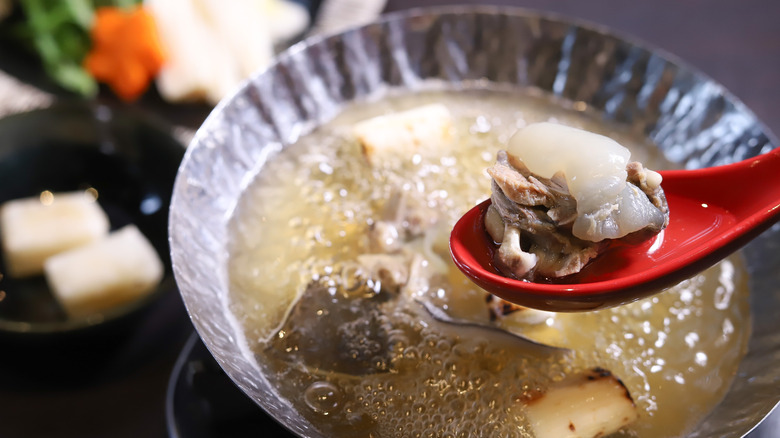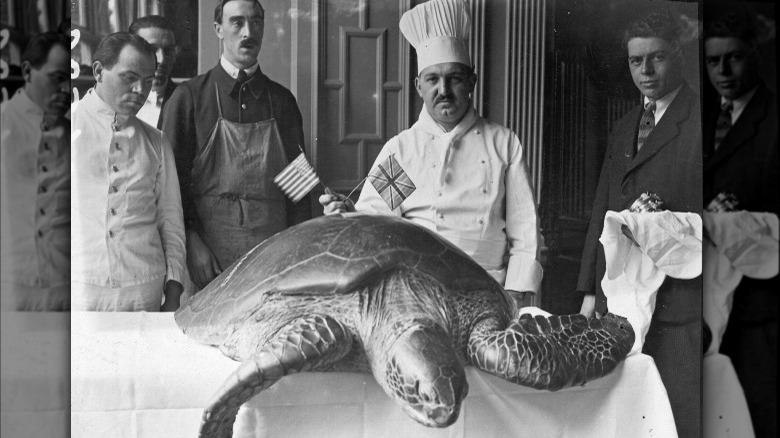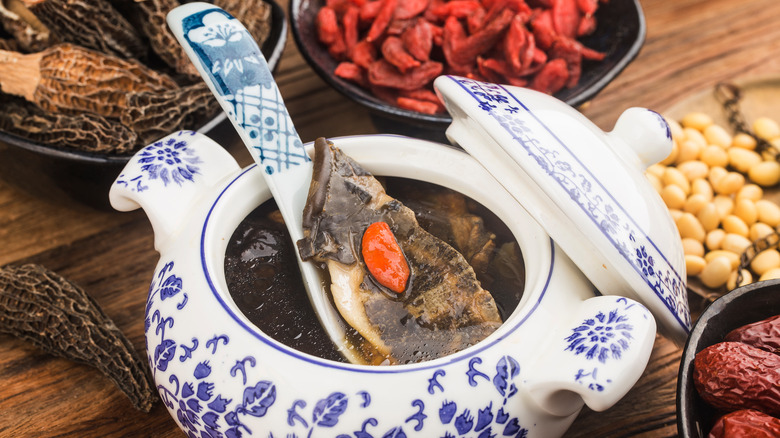How Turtle Soup Is Connected To The 4th Of July
It might be tough to picture the Founding Fathers in powdered wigs cracking open a cold one with the boys around a charcoal grill for their Independence Day celebrations. (But, just for fun, go ahead and try to picture it anyway.) Considering the first Fourth of July celebration in America involved melting a statue of King George III to reshape into bullets and burning an effigy in his likeness, per Mental Floss — maybe some things have changed over the years. But, what today's Fourth of July parties lack in chaos and charisma, they have decidedly gained by the menu. From Betsy Ross behind the sewing machine to the Flag Cake you bring to your neighbor's cookout, the colonists' original party plans have certainly benefited from a good old-fashioned American indulgence.
If today's Americans came hungry to the first 4th of July celebration, they probably would've left, and you'd be hard-pressed to find a hotdog on a colonial table. Instead, the first folks chowed down on, you guessed right, turtle soup. Ready to party yet?
Soup's on for the celebration
The story goes that John and Abigail Adams — as in, the second President and First Lady of the U.S. ever — sat down for a big steamy colonial bowl of turtle soup on July 4, 1776, per Delish — the day America is thought to have officially gained its independence from Britain. Legend has it that the couple also chowed down on poached salmon, green peas, and boiled potatoes.
While it's unknown how much fact is behind the tale, turtle soup was indeed considered a celebratory meal in the mid-eighteenth century. In "The Flow of Turtle Soup from the Caribbean via Europe to Canton, and Its Modern American Fate," scholar May-bo Ching explains how the dish ended up in the states in the first place. European sailors invading the Caribbean adopted eating sea turtles from wealthy slaveholders in the West Indies, who dined on turtle soup as a privilege flex, via JSTOR Daily. "Dressing a turtle the 'West India Way' became a must-have item in reputable cookery books published in the eighteenth and nineteenth centuries," Ching says. The trend just happened to catch on in Britain especially.
Turtle frolics are a thing of the past
By the time turtle soup reached the colonies, turtle fever was spreading like wildfire. In fact, 18th-century Americans in the South threw parties called "turtle frolics," in which eating the reptile was the principal activity, according to Saveur. Historical accounts of the turtle frolics, it says, depict servants carrying "three-foot-long upturned turtle shells filled with hot turtle stew for large crowds."
The trend continued well into the 19th century. Abraham Lincoln ate a turtle to celebrate his second presidential inauguration in 1865, per Atlas Obscura. Turtle, it says, was a favorite among such early-American elites as George Washington and Alexander Hamilton, all the way down the line to William Howard Taft –- whose famous love of fine culinary stylings literally got him stuck in a bathtub, via History.
From there, turtle soup evolved into a regional southern specialty, particularly a traditional Louisiana variety including butter, sherry, tomatoes, diced hard-boiled eggs, paprika, and cumin, via Tasteatlas. Today, turtle soup hasn't just fallen out of flavor favor -– depending on how you get your ingredients; it's also illegal. Sea turtles have been internationally protected since 1977, according to the Smithsonian, but they are still poached all over the world. Better to save that dish for the Founding Fathers and let it fade into history.


